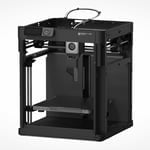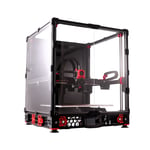Pick

- Slick user experience
- Advanced features
- Enclosed design
- Proprietary parts
- Average build volume



CoreXY 3D printers are some of the most distinctive and versatile 3D printers on the market, making them a highly interesting alternative for hobbyists and professionals due to their rigid cube-shaped design and high printing speeds.
Unlike other 3D printer designs, CoreXY printheads use a belt motion system and typically only move on the X and Y axis (hence the name). That, combined with the fact that the stepper motors are fixed to the frame and make the printer’s moving parts lighter, allows CoreXY printers to travel and print faster, all while being more accurate and stable. As such, CoreXY 3D printers are becoming more and more popular.
So far, so good, but which are the best ones out there? Following an intense period of testing, exploring the web and dark corners of forums, as well as the usual lengthy discussions among the editorial team, we’ve come up with a list of the best CoreXY printers currently available.
Without further ado, let’s get right to the core.
Before making a final decision, here are some things to consider when buying a CoreXY 3D printer.
CoreXY 3D printers generally offer some advantages over normal, bed-slinger Cartesian-style 3D printers, mainly speed and precision. Due to the mechanical arrangement, CoreXY 3D printers have fewer moving parts during printing, which reduces inertia and generally allows for much higher print speeds without causing as many print artifacts, such as ghosting and ringing.
This superb mechanical setup does come at the price of being more complex to set up and maintain. The belts and pulleys, especially, require care and upkeep as they need to be properly tensioned. Luckily, some CoreXY 3D printers feature automatic belt tension detection, informing users when to re-tighten the belts. If you are not too confident in your mechanical abilities, looking out for some of the more user-friendly machines might well be worth it.
This also applies to the assembly. A lot of CoreXY 3D printers originally stem from the maker community and come as kits for the user to assemble. Building one of these machines requires some know-how, but there are ready-out-of-the-box machines around these days as well.
Leveling the bed manually on CoreXY 3D printers can be a difficult task, especially for someone just starting out. So, automatic bed leveling is one of the crucial features we looked for in these printers. What’s more, advanced features such as vibration compensation or pressure advance are becoming more and more present on 3D printers thanks to the likes of Klipper. Especially when printing fast, these can yield even cleaner printing results and generally get the best out of a machine. Machines that either run it natively or can be upgraded to are highly desirable, making their usage as uncomplicated and simple as possible.
Naturally, having a large and active community, especially for the more maker-based machines, is always helpful. Not only for new users and beginners but also for experienced users who want to gradually optimize and expand their printing experience.
With all this in mind, here are the best CoreXY 3D printers currently around.

The Bambu Lab X1 Carbon is a revolutionary piece of 3D printing tech – the CoreXY 3D printer comes with a whole lot of new tech packed into it.
With a build volume of 256 x 256 x 256 mm, the fully-enclosed X1 Carbon offers a decent build area and, thanks to its 300 °C hot end and 110 °C print bed, the list of materials ranges from everyday filaments such as PLA and PETG to more professional one such as PC, ABS, or carbon reinforced blends — the included hardened steel nozzle also ensures those later abrasive materials won’t make short work of your nozzle.
Thanks to its CoreXY kinematics, the X1 Carbon can print at top speeds of up to 500 mm/s, although its default printing speed is somewhere around the 250 mm/s mark. An impressive feat nonetheless, especially as the X1 produces more than decent print results. For even faster prints, you can gear up into “Speed” or “Ludicrous” mode.
Producing high-quality prints at such speeds is also thanks to the next-gen tech integrated into the machine. Features include lidar-guided bed leveling and first layer inspection, active vibration compensation, pressure advance, and “spaghetti detection” where the AI checks out the current print and informs the user when something has gone pear-shaped. Thanks to Bambu Lab’s mobile app, you can monitor the print via its inbuilt HD camera as well as get notified via push message if something has gone awry. Tinkering? Not necessary. Lengthy investigations into odd issues? A thing of the past.
Preparing prints is done via Bambu Lab’s proprietary slicer, Bambu Studio, which offers all the necessary tools and allows you to remotely send and start prints via Wi-Fi. The X1 Carbon does come with a large 5-inch color touchscreen and neat UI, however, you most likely won’t be using it very often. Sending, staring, and monitoring prints from your computer is just too comfortable.
Priced at $1,199, the X1 Carbon is no cheap investment. But, for the money, you get one of the, if not the, most advanced 3D printers currently available in the consumer sector, which takes much of the tinkering and fine-tuning out of the users’ hands. The 3D printer comes fully assembled and pre-calibrated, meaning it is ready to go out of the box and, thanks to its many advanced features, offers great print results. Paired with the CoreXY inherent print speeds, the X1 Carbon knocks it out of the park.
For an additional $349, or a combo pre-order price of $1,449, you can even hook up Bambu Lab’s Automatic Material System (AMS) to the X1, a 4-way material changer that is placed on top of the printer. This allows for multi-material and multi-color prints. The box itself comes equipped with sensors to monitor humidity and the amount of filament left, as well as a sensor to detect what that filament actually is – if it’s a Bambu Lab material.


If you want (most of) the Bambu Lab X1 Carbon’s features without copping out quite so much money, cast your eye on the Bambu Lab P1P. It is a somewhat stripped-down version of the X1 series machine that does away with fancier garnish like a touch screen and lidar sensors, as well as the enclosure, in order to produce a more affordable model. It retains key aspects of the X1 though, including its kinematics, “state-of-the-art electronics”, as well as vibration compensation and pressure advance.
Even without an enclosure, the P1P provides a stable cube frame that, together with its CoreXY setup, allows it to go full throttle when it comes to print speeds. To enclose the printer, users can 3D print side panels for the P1P themselves using Bambu Lab’s “Modplate” files, which allow you to fully customize your printer and create a somewhat more suitable environment for temperature-sensitive filaments.
Like the X1, the build volume is decently sized at 256 x 256 x 256 mm, and the direct extruder and 300 °C-capable hot end allow for a wide palette of filaments to be used (though it doesn’t have the X1’s hardened nozzle). Depending on the material, a bit of tweaking to the print settings — mainly speed — might be advised to get even cleaner-looking prints; but, for everyday materials, the P1P knocks it out of the park. With default print speeds of about 250 mm/s and the potential for even faster movement, the P1P creates some rapidly-produced, high-quality prints with very little effort.
The P1P does see changes when it comes to its print bed. Instead of a smooth surface, the P1P comes with a flexible PEI-covered spring steel plate that, unlike the X1 Carbon’s, does not need extra adhesives to keep the print in place. Also, instead of the large touchscreen, the P1P comes with a small 2.7-inch LCD with a clicky wheel. Arguably not the most contemporary, but thanks to its Wi-Fi connectivity and remote monitoring via the Bambu Studio slicer or the mobile app, interaction with the printer is mostly done remotely anyways. Some features found on the X1, like a camera for further inspection of prints, can be added later on via upgrades, should you wish.
Currently available for $699, the P1P isn’t particularly cheap, but the unit comes with premium features like a PEI-coated flex plate and auto bed leveling, alongside advanced features such as input shaping and pressure advance, and can be upgraded with a monitoring camera and light. Being compatible with Bambu Lab’s $349 four-color AMS unit for multicolor prints is a big plus, too.
Although “only” the offshoot printer from Bambu Lab, the P1P feels and behaves like the total package in many ways and, once you slap some panels onto it, it even looks like it. If you want a CoreXY 3D printer that produces fast, quality prints without tinkering, the P1P is an offer that is hard to find for its price.


The Voron project started back in 2015 with the goal of releasing an open-source, no-compromise 3D printer, and ever since the team has done a stellar job of designing professional-looking and strong-performing machines. The Voron 2.4 is the latest version of Voron’s flagship and largest open-source CoreXY 3D printer.
It’s not just the Voron’s neat aesthetics that make this machine stand out, it’s a unique 3D printer in many aspects. For starters, it is one of the few designs that use belts and linear rails for all three axes instead of the typically used Z-axis lead screw. Plus, its print bed is stationary, reducing movement and vibrations. What’s more, the 3D printer uses four-axis leveling, physically aligning the print bed with stepper motors located on each corner of the bed, based on the feedback from the printer’s onboard leveling probe.
Probably its biggest difference from the other machines on this list, however, is the fact that Voron doesn’t sell 3D printers or even parts. As the project is fully open-source, you will have to source all the parts for the 3D printer and assemble it yourself. Thankfully for a project of this nature, Voron documentation goes above and beyond expectations, and the strong and active community around the project can be especially helpful for newcomers to get the hang of this machine. Nevertheless, a base knowledge of electrical and mechanical components won’t hurt.
You can also order a bundle kit with all the non-printable parts from third-party resellers online if you don’t want to source the parts independently, but be aware that you might get off-brand components. You will also have to 3D print parts for it, so you need access to a 3D printer beforehand. That way, you can set your personal color scheme for your printer, though.
The bill of materials can be found on the Voron website, and you can select from various options for the Voron you’re planning to build such as direct or Bowden drive and even the print bed size. Available in three different sizes, 250 x 250 x 250 mm, 300 x 300 x 300 mm, and 350 x 350 x 350 mm, the printer comes with pretty much everything (if you go for a bundle kit), including a 32-bit BTT Octopus mainboard with silent stepper drivers, Klipper and Wi-Fi connectivity, and a heated chamber with a HEPA filter.
The Voron 2.4 has an all-metal hot end that readily reaches the 285°C needed to print exotic materials like nylon and polycarbonate and generally prints at about 150 mm/s default print speed. You can easily crank it up to 250 mm/s, though, thanks to advanced features such as resonance compensation built into its Klipper firmware.
If you want an accurate and reliable workhorse CoreXY 3D printer that you can fully customize yourself, and don’t shy away from the involved assembly, the Voron 2.4 is an enticing option.

Our top three are not, by any means, the only CoreXY 3D printers out there. Here are some honorable mentions that didn’t make it on this list. They are not bad systems, they just can’t quite keep up with our top three.
If you are looking for an affordable entry into CoreXY 3D printing, check out the Tronxy X5SA. It offers a staggering price tag of less than $300 for the printer’s large build volume of 330 x 330 x 400 mm and an automatic bed leveling probe. In general, the Tronxy X5SA is a solid foundation for customization, but requires some tweaking and maintenance. To unleash its full potential, some immediate out-of-the-box modifications, such as a 3D printable cable chain fixture or the upgrade to a coated glass bed, are advisable. For beginners, this could prove to be overwhelming. But, in the right hands and once properly dialed in, it can work quite well.
The Creativity 3D Elf is another competitively priced CoreXY 3D printer with a large 300 x 300 x 350 mm build volume. Similar to the Tronxy X5SA, the printer comes as a kit and will require assembling to get up and running.
If you want a bit more premium, cast your eyes on the Rat Rig V-Core 3 – a sturdy Core-XY printer that comes in different versions and can be pre-configured by the user. Similar to the Voron, you can order a complete kit including an E3D V6 hot end, Bondtech Extruder, Duet 3 Mini 5+ controller board with Wi-Fi compatibility, BLTouch automatic bed leveling sensor, and a flexible PEI build plate. Premium features for a premium price.
If you want a small but capable CoreXY workhorse that you can fully customize to your needs, the Voron 01 is an enticing option. At 120 x 120 x 120 mm, it is one of the smallest CoreXY printers available, but that doesn’t stop it from being an exceptional 3D printer. Like its bigger brother, you can fully customize it to your needs.
This article is updated on a rolling basis, so when something good enough to qualify for this list has been tested, we pop it straight in. Below you will find the changelog.
Just because a printer drops off this list doesn’t mean it’s bad — far from it. We’ll be keeping track of all the printers that have been removed and the printers that replaced them here so you can easily see our past top picks.
Update – March 1, 2023: We’ve overhauled this guide to focus in greater detail on the three main machines we feel people should consider when opting for a CoreXY 3D printer. Thanks to the meteoric rise of the Bambu Lab printers, CoreXY 3D printers seem to be more popular than ever. We have updated our picks to reflect that and removed some of the old machines listed. They haven’t gone sour, but with the capability and ease of use our top picks offer, they just can’t keep up. We’ve also listed some alternatives and added a little section on what to look for in a CoreXY 3D printer.
License: The text of "The Best CoreXY 3D Printers of 2023" by All3DP is licensed under a Creative Commons Attribution 4.0 International License.
CERTAIN CONTENT THAT APPEARS ON THIS SITE COMES FROM AMAZON. THIS CONTENT IS PROVIDED ‘AS IS’ AND IS SUBJECT TO CHANGE OR REMOVAL AT ANY TIME.